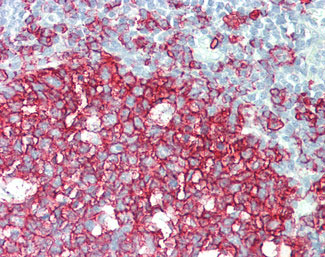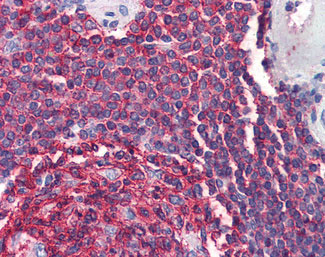CD20 Antibody (C-Terminus)
Goat Polyclonal Antibody
- SPECIFICATION
- CITATIONS
- PROTOCOLS
- BACKGROUND

Application
| WB, IHC-P, E |
|---|---|
| Primary Accession | P11836 |
| Host | Goat |
| Clonality | Polyclonal |
| Calculated MW | 33kDa |
| Dilution | IHC-P (2-2.5 µg/ml), WB (3-5 µg/ml), |
| Gene ID | 931 |
|---|---|
| Other Names | B-lymphocyte antigen CD20, B-lymphocyte surface antigen B1, Bp35, Leukocyte surface antigen Leu-16, Membrane-spanning 4-domains subfamily A member 1, CD20, MS4A1, CD20 |
| Target/Specificity | Human CD20 / MS4A1 |
| Reconstitution & Storage | Store vial at -20 C or below prior to opening. For extended storage, aliquot contents and freeze at -20 C or below. Avoid cycles of freezing and thawing. Dilute only prior to immediate use. |
| Precautions | CD20 Antibody (C-Terminus) is for research use only and not for use in diagnostic or therapeutic procedures. |
| Name | MS4A1 |
|---|---|
| Synonyms | CD20 |
| Function | B-lymphocyte-specific membrane protein that plays a role in the regulation of cellular calcium influx necessary for the development, differentiation, and activation of B-lymphocytes (PubMed:12920111, PubMed:3925015, PubMed:7684739). Functions as a store-operated calcium (SOC) channel component promoting calcium influx after activation by the B-cell receptor/BCR (PubMed:12920111, PubMed:18474602, PubMed:7684739). |
| Cellular Location | Cell membrane; Multi-pass membrane protein. Cell membrane; Lipid-anchor. Note=Constitutively associated with membrane rafts. |
| Tissue Location | Expressed on B-cells. |

Thousands of laboratories across the world have published research that depended on the performance of antibodies from Abcepta to advance their research. Check out links to articles that cite our products in major peer-reviewed journals, organized by research category.
info@abcepta.com, and receive a free "I Love Antibodies" mug.
Provided below are standard protocols that you may find useful for product applications.
Background
This protein may be involved in the regulation of B-cell activation and proliferation.
References
Stamenkovic I.,et al.J. Exp. Med. 167:1975-1980(1988).
Tedder T.F.,et al.Proc. Natl. Acad. Sci. U.S.A. 85:208-212(1988).
Einfeld D.A.,et al.EMBO J. 7:711-717(1988).
Tedder T.F.,et al.J. Immunol. 142:2560-2568(1989).
Ota T.,et al.Nat. Genet. 36:40-45(2004).
If you have used an Abcepta product and would like to share how it has performed, please click on the "Submit Review" button and provide the requested information. Our staff will examine and post your review and contact you if needed.
If you have any additional inquiries please email technical services at tech@abcepta.com.













 Foundational characteristics of cancer include proliferation, angiogenesis, migration, evasion of apoptosis, and cellular immortality. Find key markers for these cellular processes and antibodies to detect them.
Foundational characteristics of cancer include proliferation, angiogenesis, migration, evasion of apoptosis, and cellular immortality. Find key markers for these cellular processes and antibodies to detect them. The SUMOplot™ Analysis Program predicts and scores sumoylation sites in your protein. SUMOylation is a post-translational modification involved in various cellular processes, such as nuclear-cytosolic transport, transcriptional regulation, apoptosis, protein stability, response to stress, and progression through the cell cycle.
The SUMOplot™ Analysis Program predicts and scores sumoylation sites in your protein. SUMOylation is a post-translational modification involved in various cellular processes, such as nuclear-cytosolic transport, transcriptional regulation, apoptosis, protein stability, response to stress, and progression through the cell cycle. The Autophagy Receptor Motif Plotter predicts and scores autophagy receptor binding sites in your protein. Identifying proteins connected to this pathway is critical to understanding the role of autophagy in physiological as well as pathological processes such as development, differentiation, neurodegenerative diseases, stress, infection, and cancer.
The Autophagy Receptor Motif Plotter predicts and scores autophagy receptor binding sites in your protein. Identifying proteins connected to this pathway is critical to understanding the role of autophagy in physiological as well as pathological processes such as development, differentiation, neurodegenerative diseases, stress, infection, and cancer.




